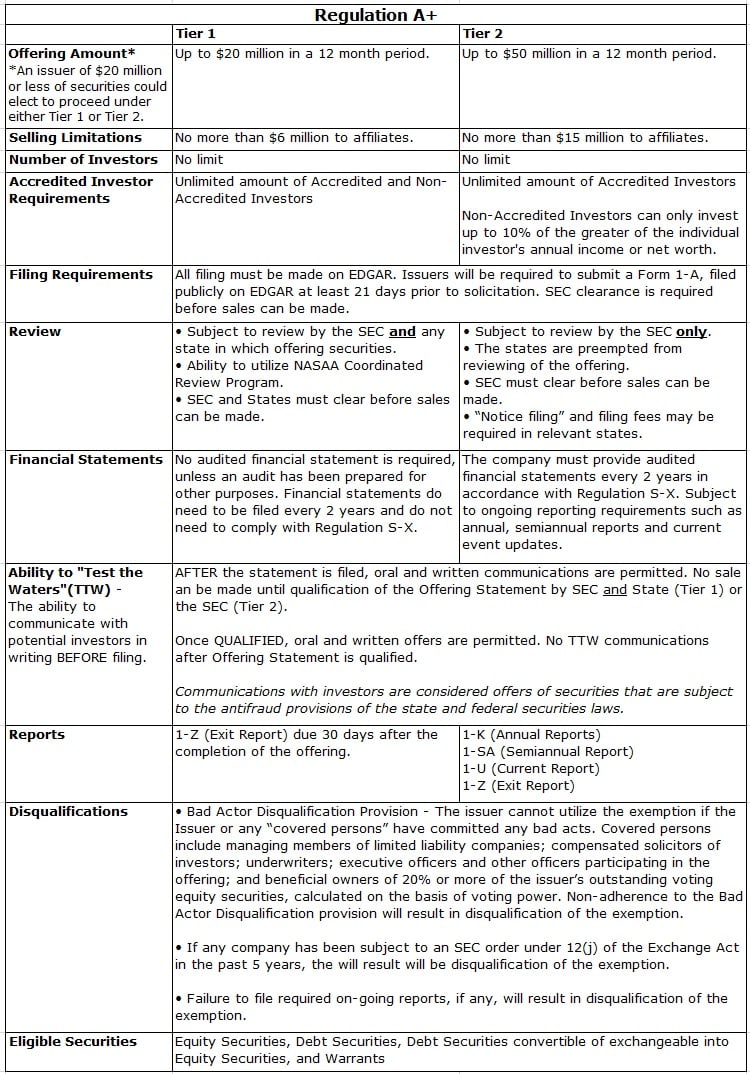We’ve been receiving some questions as of late from registered investment adviser (RIA) firms as it relates to the Jumpstart Our Business Startups Act otherwise known as the JOBS Act. Often, clients of RIA firms are reaching out to their advisers when exploring private company investment opportunities. As such, this post is intended to provide some basic educational information on the rapidly evolving capital raising regulations for small businesses.
Note: RIA in a Box LLC is not a law firm and does not provide legal advice. We strongly advise that all companies consult with proper legal counsel for all matters related to the Regulation A and the JOBS Act. This overview is provided for general information purposes only and should not be relied upon to take any action. RIA in a Box LLC does not offer any services or assistance with regards to private securities offerings.
The Securities and Exchange Commission (SEC) has amended the existing exemption from SEC registration for small public offerings of securities known as Regulation A under the Securities Act of 1933. The amended Regulation A exemption is now commonly referred to as Regulation A+. The final rule issued by the SEC on March 25, 2015 will go into effect in 60 days — on or about Memorial Day. Small businesses and emerging companies are excited about the changes because the burden and expense of compliance has become much easier with the amendment.
By way of background, Regulation A was amended in order to implement Section 401 of the Jumpstart Our Business Startups Act otherwise known as the JOBS Act. A significant advantage of Regulation A is that securities issued thereunder are not restricted from resale, whereas restrictions on resale apply to many other private placement rules, such as Regulation D Rule 506 and the proposed Title III Crowdfunding rules.
Regulation A+ has now granted issuers increased ability to reach the average retail investor and lessened the delay, burden, and expense to issuers by preempting state-level review. Specifically, it offers an exemption for small public offerings seeking to raise up to $50 million (previously $5 million) from accredited and non-accredited investors within a 12 month period. The exemption has been expanded into two tiers: Tier 1, for securities offerings of up to $20 million; and Tier 2, for offerings of up to $50 million. The amendment modifies both Tier 1 and Tier 2 offerings, including issues of the “bad actor” disqualification, offering circular contents, issuer eligibility, and communication with potential investors (“testing the waters” provisions).
While the SEC is describing the final rules goal to “modernize the Regulation A filing process for all offerings, align practice in certain areas with prevailing practice for registered offerings, create additional flexibility for issuers in the offering process, and establish an ongoing reporting regime for Regulation A issuers.”, many state regulators are concerned because the revision preempts state review of Tier 2 offerings (described below). Under the revised regulation, states will no longer have the ability to conduct a merit review regarding the fairness of the offering or ensure that the required material disclosure is relayed to potential investors across the 50 states.
Overall, issuers’ use of Regulation A has been somewhat inhibited in the past because of a series of compliance requirements imposed by each state in which the offering was solicited to investors (commonly known as “blue sky” laws) The compliance obligations and offering cost previously led many issuers to consider Regulation A, in its prior iteration, an inefficient option given the $5 million fundraising cap. As revised, Regulation A+ is intended to afford small businesses organized in the United States and Canada the ability to more easily raise greater amounts of capital without the burden of becoming fully registered.
The table below illustrates the differences and similarities between Tier 1 and Tier 2 Regulation A offerings in some detail according to the amended exemption:

Source of table information: http://www.sec.gov/rules/final/2015/33-9741.pdf